2008 GMC SAVANA steering
[x] Cancel search: steeringPage 62 of 402
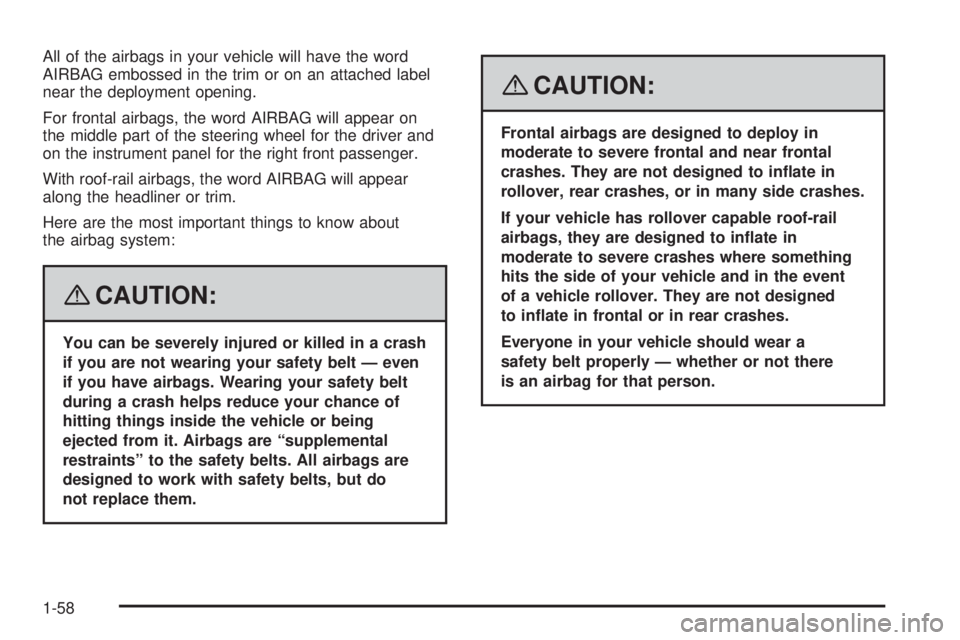
All of the airbags in your vehicle will have the word
AIRBAG embossed in the trim or on an attached label
near the deployment opening.
For frontal airbags, the word AIRBAG will appear on
the middle part of the steering wheel for the driver and
on the instrument panel for the right front passenger.
With roof-rail airbags, the word AIRBAG will appear
along the headliner or trim.
Here are the most important things to know about
the airbag system:
{CAUTION:
You can be severely injured or killed in a crash
if you are not wearing your safety belt — even
if you have airbags. Wearing your safety belt
during a crash helps reduce your chance of
hitting things inside the vehicle or being
ejected from it. Airbags are “supplemental
restraints” to the safety belts. All airbags are
designed to work with safety belts, but do
not replace them.
{CAUTION:
Frontal airbags are designed to deploy in
moderate to severe frontal and near frontal
crashes. They are not designed to in�ate in
rollover, rear crashes, or in many side crashes.
If your vehicle has rollover capable roof-rail
airbags, they are designed to in�ate in
moderate to severe crashes where something
hits the side of your vehicle and in the event
of a vehicle rollover. They are not designed
to in�ate in frontal or in rear crashes.
Everyone in your vehicle should wear a
safety belt properly — whether or not there
is an airbag for that person.
1-58
Page 64 of 402
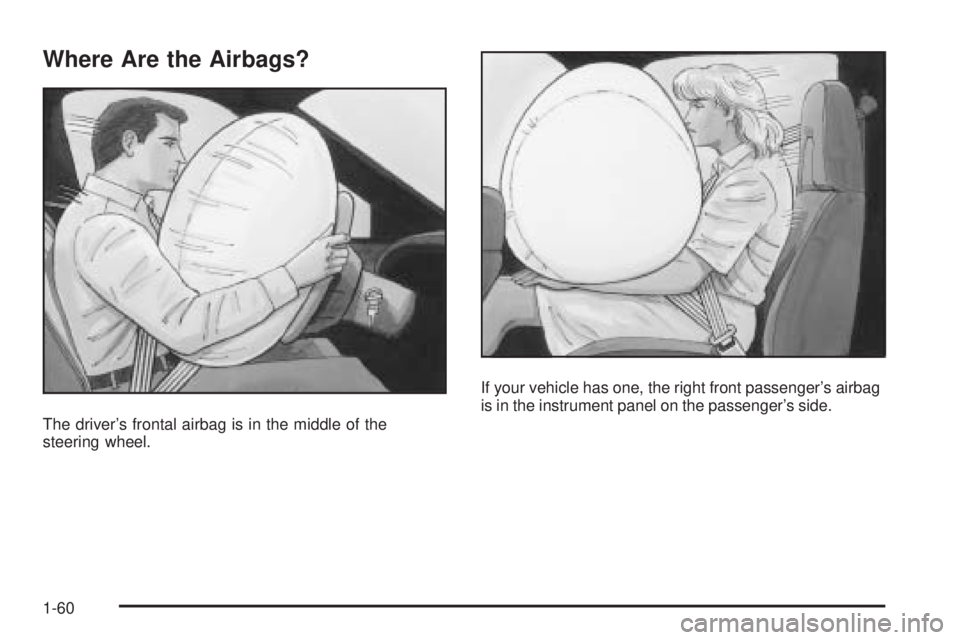
Where Are the Airbags?
The driver’s frontal airbag is in the middle of the
steering wheel.If your vehicle has one, the right front passenger’s airbag
is in the instrument panel on the passenger’s side.
1-60
Page 66 of 402
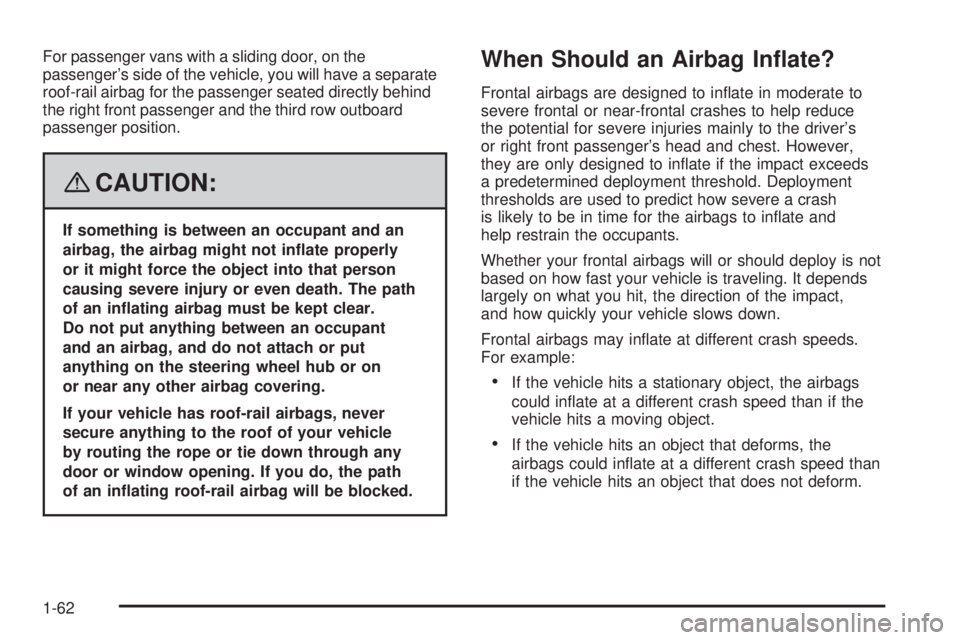
For passenger vans with a sliding door, on the
passenger’s side of the vehicle, you will have a separate
roof-rail airbag for the passenger seated directly behind
the right front passenger and the third row outboard
passenger position.
{CAUTION:
If something is between an occupant and an
airbag, the airbag might not in�ate properly
or it might force the object into that person
causing severe injury or even death. The path
of an in�ating airbag must be kept clear.
Do not put anything between an occupant
and an airbag, and do not attach or put
anything on the steering wheel hub or on
or near any other airbag covering.
If your vehicle has roof-rail airbags, never
secure anything to the roof of your vehicle
by routing the rope or tie down through any
door or window opening. If you do, the path
of an in�ating roof-rail airbag will be blocked.
When Should an Airbag In�ate?
Frontal airbags are designed to inflate in moderate to
severe frontal or near-frontal crashes to help reduce
the potential for severe injuries mainly to the driver’s
or right front passenger’s head and chest. However,
they are only designed to inflate if the impact exceeds
a predetermined deployment threshold. Deployment
thresholds are used to predict how severe a crash
is likely to be in time for the airbags to inflate and
help restrain the occupants.
Whether your frontal airbags will or should deploy is not
based on how fast your vehicle is traveling. It depends
largely on what you hit, the direction of the impact,
and how quickly your vehicle slows down.
Frontal airbags may inflate at different crash speeds.
For example:
•If the vehicle hits a stationary object, the airbags
could inflate at a different crash speed than if the
vehicle hits a moving object.
•If the vehicle hits an object that deforms, the
airbags could inflate at a different crash speed than
if the vehicle hits an object that does not deform.
1-62
Page 68 of 402
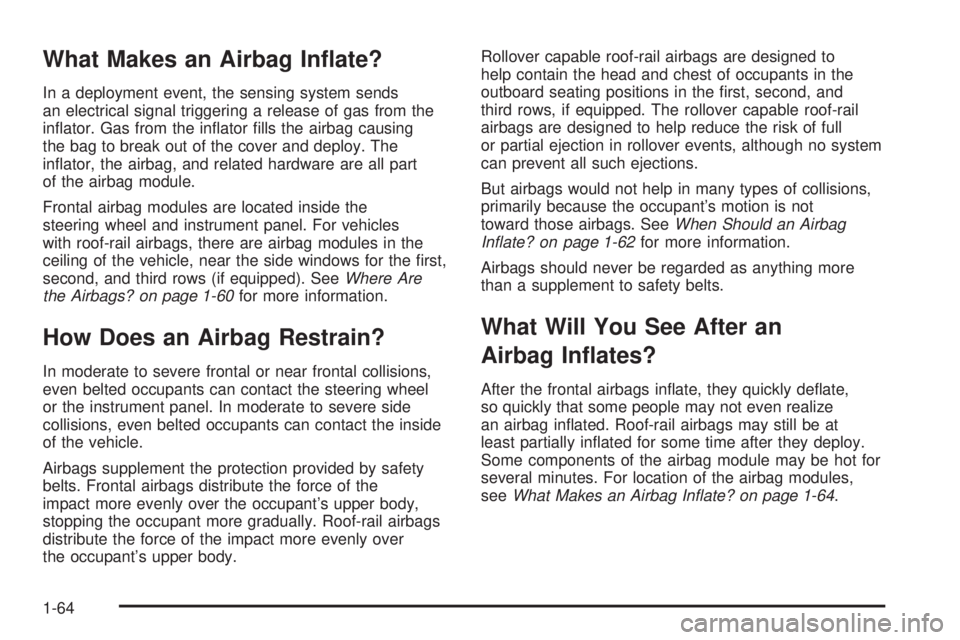
What Makes an Airbag In�ate?
In a deployment event, the sensing system sends
an electrical signal triggering a release of gas from the
inflator. Gas from the inflator fills the airbag causing
the bag to break out of the cover and deploy. The
inflator, the airbag, and related hardware are all part
of the airbag module.
Frontal airbag modules are located inside the
steering wheel and instrument panel. For vehicles
with roof-rail airbags, there are airbag modules in the
ceiling of the vehicle, near the side windows for the first,
second, and third rows (if equipped). SeeWhere Are
the Airbags? on page 1-60for more information.
How Does an Airbag Restrain?
In moderate to severe frontal or near frontal collisions,
even belted occupants can contact the steering wheel
or the instrument panel. In moderate to severe side
collisions, even belted occupants can contact the inside
of the vehicle.
Airbags supplement the protection provided by safety
belts. Frontal airbags distribute the force of the
impact more evenly over the occupant’s upper body,
stopping the occupant more gradually. Roof-rail airbags
distribute the force of the impact more evenly over
the occupant’s upper body.Rollover capable roof-rail airbags are designed to
help contain the head and chest of occupants in the
outboard seating positions in the first, second, and
third rows, if equipped. The rollover capable roof-rail
airbags are designed to help reduce the risk of full
or partial ejection in rollover events, although no system
can prevent all such ejections.
But airbags would not help in many types of collisions,
primarily because the occupant’s motion is not
toward those airbags. SeeWhen Should an Airbag
Inflate? on page 1-62for more information.
Airbags should never be regarded as anything more
than a supplement to safety belts.
What Will You See After an
Airbag In�ates?
After the frontal airbags inflate, they quickly deflate,
so quickly that some people may not even realize
an airbag inflated. Roof-rail airbags may still be at
least partially inflated for some time after they deploy.
Some components of the airbag module may be hot for
several minutes. For location of the airbag modules,
seeWhat Makes an Airbag Inflate? on page 1-64.
1-64
Page 78 of 402

Adding Equipment to Your
Airbag-Equipped Vehicle
Q:Is there anything I might add to or change
about the vehicle that could keep the airbags
from working properly?
A:Yes. If you add things that change your vehicle’s
frame, bumper system, height, front end or side
sheet metal, they may keep the airbag system from
working properly. Changing or moving any parts
of the front seats, safety belts, the airbag sensing
and diagnostic module, steering wheel, instrument
panel, roof-rail airbag modules, ceiling headliner
or pillar garnish trim, front sensors, or airbag wiring
can affect the operation of the airbag system.
In addition, your vehicle may have a passenger
sensing system for the right front passenger’s
position, which includes sensors that are part
of the passenger’s seat. The passenger sensing
system may not operate properly if the original
seat trim is replaced with non-GM covers,
upholstery or trim, or with GM covers, upholstery
or trim designed for a different vehicle. Any object,
such as an aftermarket seat heater or a comfort
enhancing pad or device, installed under or on top
of the seat fabric, could also interfere with the
operation of the passenger sensing system.This could either prevent proper deployment of
the passenger airbag(s) or prevent the passenger
sensing system from properly turning off the
passenger airbag(s). SeePassenger Sensing
System on page 1-69.
If you have any questions about this, you should
contact Customer Assistance before you modify
your vehicle. The phone numbers and addresses
for Customer Assistance are in Step Two of
the Customer Satisfaction Procedure in this manual.
SeeCustomer Satisfaction Procedure on page 7-2.
Q:Because I have a disability, I have to get
my vehicle modi�ed. How can I �nd out whether
this will affect my airbag system?
A:If you have questions, call Customer Assistance.
The phone numbers and addresses for Customer
Assistance are in Step Two of the Customer
Satisfaction Procedure in this manual. See
Customer Satisfaction Procedure on page 7-2.
In addition, your dealer/retailer and the service manual
have information about the location of the airbag sensors,
sensing and diagnostic module and airbag wiring.
1-74
Page 102 of 402
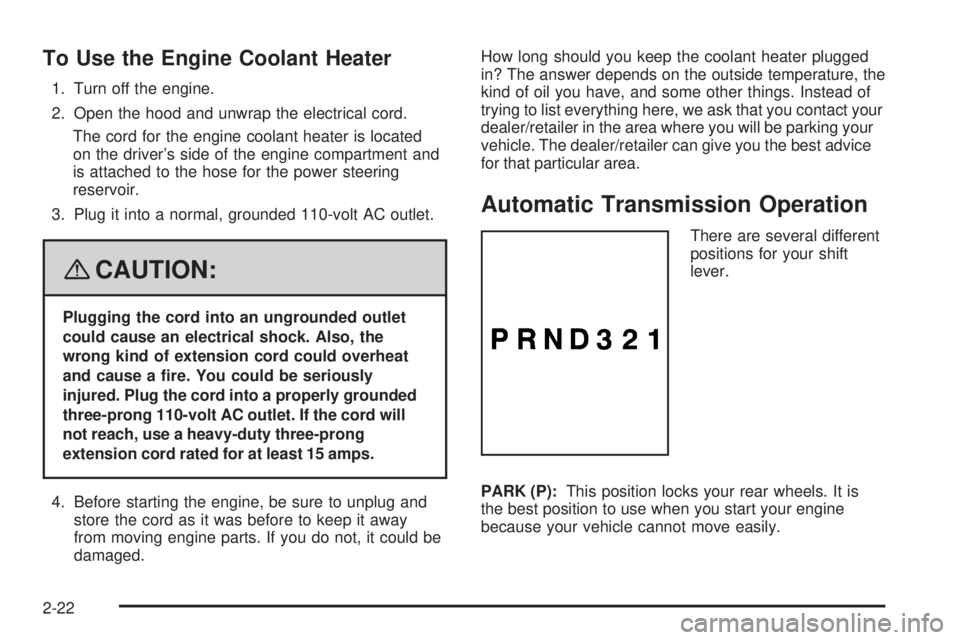
To Use the Engine Coolant Heater
1. Turn off the engine.
2. Open the hood and unwrap the electrical cord.
The cord for the engine coolant heater is located
on the driver’s side of the engine compartment and
is attached to the hose for the power steering
reservoir.
3. Plug it into a normal, grounded 110-volt AC outlet.
{CAUTION:
Plugging the cord into an ungrounded outlet
could cause an electrical shock. Also, the
wrong kind of extension cord could overheat
and cause a �re. You could be seriously
injured. Plug the cord into a properly grounded
three-prong 110-volt AC outlet. If the cord will
not reach, use a heavy-duty three-prong
extension cord rated for at least 15 amps.
4. Before starting the engine, be sure to unplug and
store the cord as it was before to keep it away
from moving engine parts. If you do not, it could be
damaged.How long should you keep the coolant heater plugged
in? The answer depends on the outside temperature, the
kind of oil you have, and some other things. Instead of
trying to list everything here, we ask that you contact your
dealer/retailer in the area where you will be parking your
vehicle. The dealer/retailer can give you the best advice
for that particular area.
Automatic Transmission Operation
There are several different
positions for your shift
lever.
PARK (P):This position locks your rear wheels. It is
the best position to use when you start your engine
because your vehicle cannot move easily.
2-22
Page 105 of 402

SECOND (2):This position reduces vehicle speed even
more than THIRD (3) without using your brakes. You
can use SECOND (2) on hills. It can help control your
speed as you go down steep mountain roads, but then
you would also want to use your brakes off and on.
You may use this feature for reducing torque to the rear
wheels when you are trying to start your vehicle from a
stop on slippery road surfaces.
FIRST (1): This position reduces vehicle speed even
more than SECOND (2) without using your brakes. You
can use it on very steep hills, or in deep snow or mud.
If the shift lever is put in FIRST (1) while the vehicle is
moving forward, the transmission will not shift into first
gear until the vehicle is going slowly enough.
Notice:Spinning the tires or holding the vehicle in
one place on a hill using only the accelerator
pedal may damage the transmission. The repair will
not be covered by your warranty. If you are stuck,
do not spin the tires. When stopping on a hill,
use the brakes to hold the vehicle in place.Tow/Haul Mode
Tow/haul is designed to assist while your vehicle is
pulling a large or heavy load or trailer. Tow/haul is most
useful while pulling such a load in rolling terrain, in
stop-and-go traffic, or when you need improved
low-speed control, such as when parking. The purpose
of the tow/haul mode is to:
•Reduce the frequency and improve the predictability
of transmission shifts,
•provide the same solid shift feel when pulling a
heavy load as when the vehicle is unloaded,
•improve control of vehicle speed while requiring
less throttle pedal activity.
Press this button located
to the right of the steering
wheel on the instrument
panel to turn tow/haul
mode on and off.
2-25
Page 116 of 402

Highbeam On Light.......................................3-40
Tow/Haul Mode Light....................................3-40
Fuel Gage...................................................3-41
Driver Information Center (DIC).......................3-42
DIC Operation and Displays...........................3-42
DIC Compass..............................................3-47
DIC Warnings and Messages.........................3-49
DIC Vehicle Customization.............................3-58Audio System(s).............................................3-63
Setting the Clock..........................................3-65
Radio(s)......................................................3-67
Using an MP3..............................................3-77
Theft-Deterrent Feature..................................3-82
Audio Steering Wheel Controls.......................3-82
Radio Reception...........................................3-83
Fixed Mast Antenna......................................3-83
Section 3 Instrument Panel
3-2